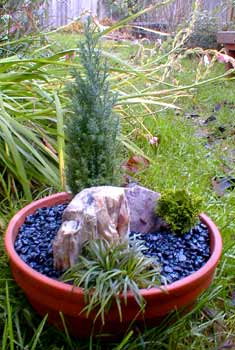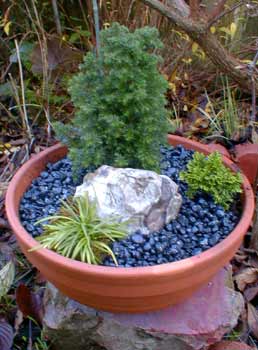
Dwarf Evergreens in Bowls
"A fool sees not the same tree a wise man sees."
-William Blake
(1757-1827)
(1757-1827)
Care of mini-dwarf potted evergreens is easy, so they make nice gifts for any friends who are already in the habit of caring for containered plants. I made the pair of bowls shown on this page for two chums whose front & back porches respectively have many lovely potted plants, to which these December gifts could be handily added.
Dwarf potted evergreens do not need much watering but should not experience a lot of drought either. They need to experience the change of seasons, just like their full-sized antecedents. So they are outdoors plants for temperate zones, typically for containers, although they certainly can be planted right out in the garden if that's preferred, keeping in mind they are extremely slow-growing & could easily be overwhelmed before they're large enough to fend for themselves among normal-sized plants.
They can be specially trained with bonsai techniques to further restrict their size, but this is not a necessity. They are mutations that naturally grow at about one-tenth the speed of their wild forms, so will remain small a great long while even without root-restriction or any other specialized bonsai care. If used for true bonsai, they would probably be best transferred to shallower bonsai-style pots, will be less drought tolerant, will need regular feedings, & in general require more attention to thrive.
When planted in slightly deeper bowl-shaped pots, instead of much shallower bonsai containers, the soil holds moisture better & needs less regular fertilizing, & the wee trees thrive without as much attention. Well-draining bowls are about halfway between true bonsai planters & deep regular upright pots, thus provide a pleasing compromise for better moisture retention without losing the general impression of bonsai presentation.
They require a full sun outdoors location, which generally means in direct sun either all morning or most of the afternoon. They may require some protection from too much sun during the hottest days of summer.
 The first bowl (above left) contains three plants. The larger of the little trees is a Port Orford Cedar (Chamaecyparis lawsoniana), which in its natural form would be a very big tree, native to Oregon. This cultivated dwarf is named 'Ellwood's Pygmy,' one of the smallest & slowest-growing of the Ellwoodii group. Its ten-year height will be about two feet even without special bonsai techniques to keep it smaller still.
The first bowl (above left) contains three plants. The larger of the little trees is a Port Orford Cedar (Chamaecyparis lawsoniana), which in its natural form would be a very big tree, native to Oregon. This cultivated dwarf is named 'Ellwood's Pygmy,' one of the smallest & slowest-growing of the Ellwoodii group. Its ten-year height will be about two feet even without special bonsai techniques to keep it smaller still.Its needles are silvery-green, adding a darker blue-green hue in winter. It is upright & somewhat narrow in youth, but will mound outward as it ages, though it could be minimally pruned to preserve the upright narrower form that makes it appear truly to be a giant conifer in miniature.
The tinier of the two trees is a Hinoki Cypress (Chamaecyparis obtusa) native to southern Japan. It is specifically a dwarf cultivar called 'JR' or 'J.R.' This variety was introduced to miniature gardening in 1960. Its cultivar name consists of the initials for Joe Reis, a famed Long Island bonsai artist who developed it from a seedling mutation. It has nevertheless come often to be pronounced "Junior" because of the size.
Though slightly pointed & bun-shaped in youth, it can grow almost as much as two inches a year in width while gaining only about one inch a year in height. At ten years of age 'JR' is usually no more than a foot tall but can be 18 to 22 inches wide, flattening & broadening with age.
The "grass" sharing the bowl is dwarf Japanese Mondo Grass (Ophiopogon japonicus var nana). It sometimes spreads aggressively by thick underground rhizomes, so it should be kept an eye-on that it doesn't begin to out-compete the miniature trees for soil nutrients. Although it looks like grass, it is a type of lily. It will produce small white flowers in summer, followed by blue-black berries in autumn.
The second bowl also has three plants, including the same evergreen Japanese Mondo Grass, & a teency Hinoki Cypress. The larger of the two little trees is the Atlantic White Cedar (Chamaecyparis thyoides), a dwarf cultivar named 'Top Point.' The natural wild form is of course enormous. But the ten year height of this dwarf is only two feet. It adds up to three or four inches a year when young, but slows down to only two inches a year as it ages. It can do with careful minor amounts of sheering to enhance its potential to be conical, but if left to its own devices may over time become more of a globe.
It was discovered as a spontaneous mutation in a Holland nursery, and developed for market by 1992. Soft young growth is a light grey-green, with plum highlights in winter.
Ultra-dwarf evergreens are so extravagant in their beauty it takes no great skill to arrange them artfully, it's very hard to go wrong. I added petrified wood for "mountains," & mulched the whole surface of the potting soil with black gravel, & voila, gifts for beloved chums who are fellow plant lovers.
For other eency trees, see:
Picea omorika 'Pimoko' dwarf Serbian spruce
and:
Chamaecyparis pisifera 'Cream Ball' miniature Japanese Falsecypress
and:
Ulmus x hollandica 'Jacqueline Hillier' dwarf elm
Picea omorika 'Pimoko' dwarf Serbian spruce
and:
Chamaecyparis pisifera 'Cream Ball' miniature Japanese Falsecypress
and:
Ulmus x hollandica 'Jacqueline Hillier' dwarf elm